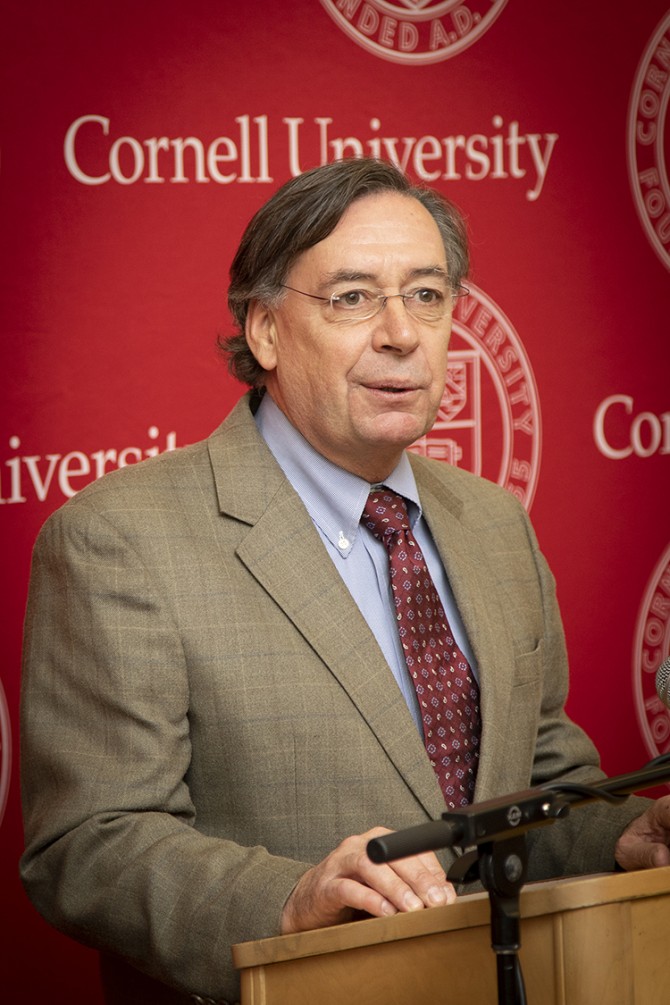Experts highlight NYS invasive species research in D.C.
By Rachel Rhodes
An invasive insect is threatening the existence of the eastern hemlock tree – the third-most prevalent tree species in New York and the state tree of Pennsylvania – and the best way to preserve it may be to introduce the invader’s natural predators.
Mark Whitmore, an extension associate in natural resources at the College of Agriculture and Life Sciences, briefed congressional staffers on the subject Feb. 26 in Washington, D.C., as part of National Invasive Species Awareness Week.
Carrie Brown-Lima, senior extension associate and director of the New York Invasive Species Research Institute at Cornell, also participated in National Invasive Species Awareness week by hosting a webinar on bridging the gap between research and management of invasive species in New York.
Whitmore leads the New York State Hemlock Initiative, which works to conserve New York’s hemlock forests threatened by the hemlock woolly adelgid, an insect native to Japan but invasive to the East Coast. He said at the briefing that the hemlock woolly adelgid has spread northward rapidly since its introduction to the East Coast in 1900s and encountered no natural predators.
“When the hemlock woolly adelgid hit the Appalachian mountains, it spread like wildfire,” he said. “If you’ve ever been to the Great Smoky Mountain National Park, you can see the destruction. Between the discovery of the insect in 2000 and 2010, every hemlock that existed in the park that wasn’t treated was dead.”
In New York, the hemlock woolly adelgid has been found in 43 counties and was discovered in the Adirondack Mountains in 2017.
Pesticides can be used in the short term to manage a hemlock woolly adelgid infestation, but in the long run, Whitmore says, a biological control program is needed.
“We need to find natural enemies for long-term control,” he said. “In its natural habitats, hemlock woolly adelgids have predators that are effective in regulating populations at non-destructive levels, but on the East Coast there are no natural enemies.”
Whitmore’s lab conducts research on several varieties of beetles and flies native to the Pacific Northwest that are the hemlock woolly adelgid’s most abundant enemies. And these insects are “specialists” – meaning they feed only on adelgids, so when their food supply disappears, so will they.
“This way, we can ensure that the natural predators won’t themselves become an invasive species,” Whitmore said.
Despite the success in identifying natural predators to the hemlock woolly adelgid, challenges remain to deploying them successfully.
Said Whitmore: “We’re at the cusp of understanding and being able to implement a biological control program, but are running up against funding roadblocks. It is expensive to get natural predators from their native habitat in Asia and the Pacific Northwest and difficult to grow them in the lab. It will take time to do the research needed to increase the numbers in the lab so we can effectively establish them in forests and save the hemlocks.”
The federal government supports research on managing invasive species through the USDA’s Forest Service and Animal and Plant Health Inspection Service, among other programs across agencies. Rep. Elise Stefanik (R-N.Y.), co-sponsor of National Invasive Species Awareness Week, is the co-chair of the bipartisan Invasive Species Caucus and has advocated for additional federal resources to address invasive species and protect habitats.
“It is essential that we continue to research ways to combat invasive species that threaten our environment,” said Stefanik, whose district comprises the North Country. “In my district in upstate New York, it is particularly important that we defend the natural habitats that attract business and tourism to our region. I am grateful to Mark Whitmore for coming to Washington to raise awareness, and to Cornell University for their dedication to the issue. I will continue to be a willing partner to them for their work on invasive species.”
Rachel Rhodes is a public affairs and media relations specialist in Cornell’s Washington, D.C., office.
Media Contact
Get Cornell news delivered right to your inbox.
Subscribe


